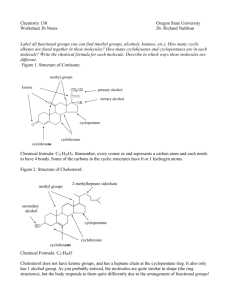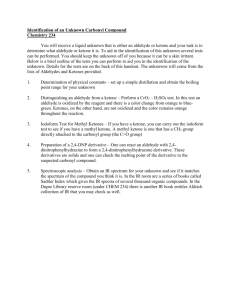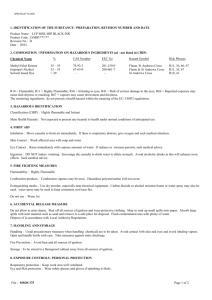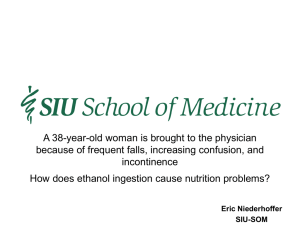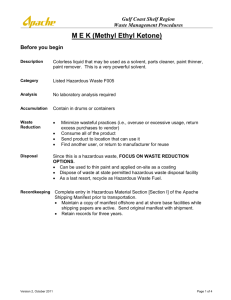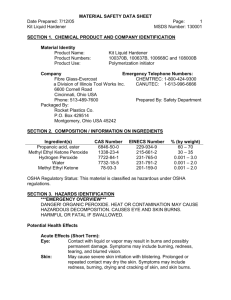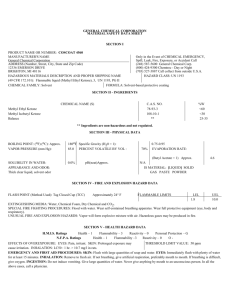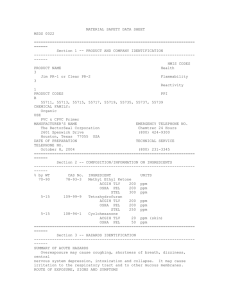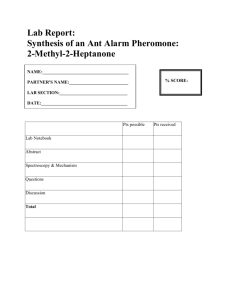Biodegradation of methyl ethyl ketone and methyl isopropyl ketone
advertisement
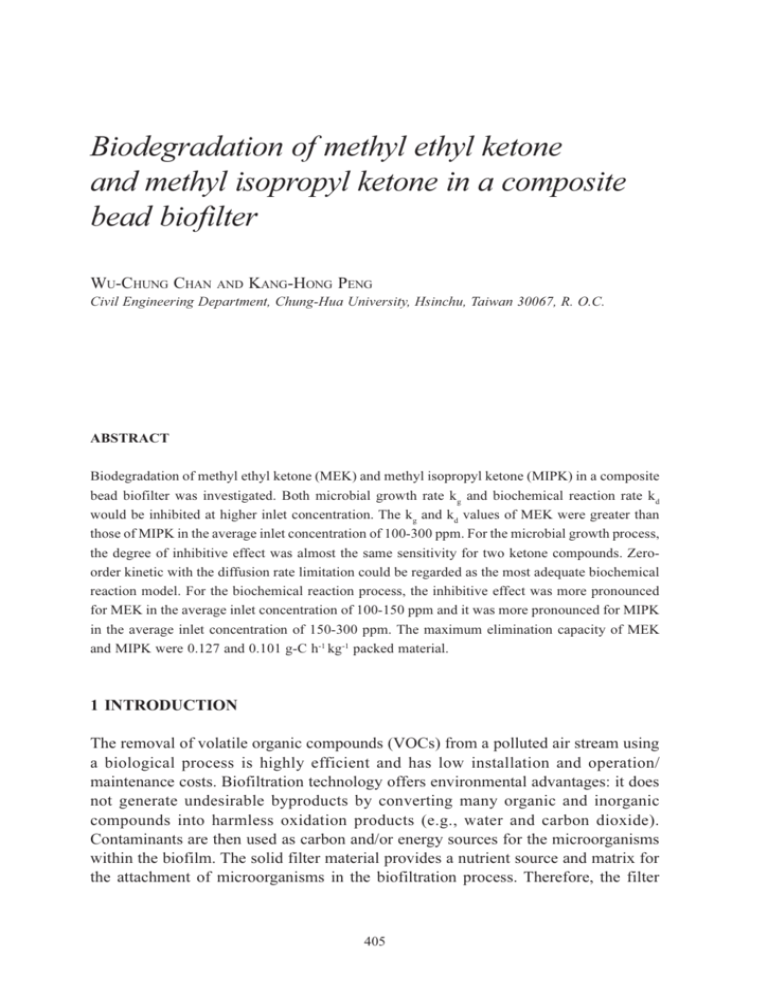
405 Biodegradation of methyl ethyl ketone and methyl isopropyl ketone in a composite bead biofilter WU-CHUNG CHAN AND KANG-HONG PENG Civil Engineering Department, Chung-Hua University, Hsinchu, Taiwan 30067, R. O.C. ABSTRACT Biodegradation of methyl ethyl ketone (MEK) and methyl isopropyl ketone (MIPK) in a composite bead biofilter was investigated. Both microbial growth rate kg and biochemical reaction rate kd would be inhibited at higher inlet concentration. The kg and kd values of MEK were greater than those of MIPK in the average inlet concentration of 100-300 ppm. For the microbial growth process, the degree of inhibitive effect was almost the same sensitivity for two ketone compounds. Zeroorder kinetic with the diffusion rate limitation could be regarded as the most adequate biochemical reaction model. For the biochemical reaction process, the inhibitive effect was more pronounced for MEK in the average inlet concentration of 100-150 ppm and it was more pronounced for MIPK in the average inlet concentration of 150-300 ppm. The maximum elimination capacity of MEK and MIPK were 0.127 and 0.101 g-C h-1 kg-1 packed material. 1 INTRODUCTION The removal of volatile organic compounds (VOCs) from a polluted air stream using a biological process is highly efficient and has low installation and operation/ maintenance costs. Biofiltration technology offers environmental advantages: it does not generate undesirable byproducts by converting many organic and inorganic compounds into harmless oxidation products (e.g., water and carbon dioxide). Contaminants are then used as carbon and/or energy sources for the microorganisms within the biofilm. The solid filter material provides a nutrient source and matrix for the attachment of microorganisms in the biofiltration process. Therefore, the filter 405 406 WU-CHUNG CHAN AND KANG-HONG PENG material property is an important factor in obtaining optimal pollutant removal. The optimal filter material should have the following characteristics: high moisture holding capacity, porosity, available nutrients, compression strength, and pH buffer capacity (Deviney et al., 1999). A spherical polyvinyl alcohol (PVA)/peat/KNO3/GAC composite bead was prepared and was proven suitable as a filter material in the biofiltration process in our previous works (Chan and Lin, 2006). The diffusivity of nutrient within the filter material was an important control factor for achieving good biofilter performance. Methyl ethyl ketone (MEK), methyl isobutyl ketone (MIBK) and methyl isopropyl ketone (MIPK) are widely used industrial chemicals. These ketone compounds were designed high-priority toxic chemicals. Large volumes of these ketone compounds are released into the atmosphere during manufacturing processes every year, leading to endanger the air quality and public health. Reports on the biodegradation of MEK and MIBK in a biofilter are limited. (Deshusses and Hamer, 1993; Deshusses et al., 1996; Deshusses, 1997; Lee et al., 2006) Recently, we had indicated that the process for degradation of VOCs in a composite bead biofilter could be divided into: lag, log growth and maximum stationary three phases; and the log growth and maximum stationary phases were important for controlling the removal efficiency of biofilter (Chan and Lin, 2006; Chan and Chang, 2006). However, details of the biodegradation kinetic in these two phases in biofilter are scant in the relevant literature. This article investigates the biochemical kinetic behaviors of MEK and MIPK in a composite bead biofilter. The composite bead is the spherical PVA/peat/ KNO3/GAC composite bead. The effect of inlet concentration and type of ketone compounds on the microbial growth rate and biochemical reaction rate are studied. 2 MATERIALS AND METHODS Peat (industrial grade from KekkilaOyj, Tuusula, Finland) was dried at 105oC before use. It has a dry density of 90 kg/m3, a pH of 5.5, a pore volume of 96%, and an organic substance content of 91%. Boric acid, sodium monobasic phosphate, sodium dibasic phosphate, potassium nitrate, methyl ethyl ketone and methyl isopropyl ketone (extra pure grade from Union Chemical, Hsinchu, Taiwan) were used as received. Poly (vinyl alcohol) (PVA) powder (industrial grade from Chung Chun Petrochemical, Hsinchu, Taiwan) and granular activated carbon (GAC) (industrial grade from Taipei Chemical, Hsinchu, Taiwan) were also used as received. The procedures for preparing PVA/peat/GAC/KNO3 composite beads and the apparatus and operation of the biofilter system were described in our previous work (Chan and Chang, 2006). Methyl ethyl ketone and methyl isopropyl ketone were used as VOCs. BIODEGRADATION OF METHYL ETHYL KETONE AND METHYL ISOPROPYL KETONE 407 3 RESULTS AND DISCUSSION The variation in the percentage of removed VOCs over operation time in an air flow rate 0.102 m3 h-1, two ketone compounds average inlet concentration in the range of 100-300 ppm, an operation temperature 30oC and a relative humidity of more than 95 % through a composite bead filter bed is shown in Figure 1. (only the average inlet concentration of 200 ppm is shown because the data for the other concentrations were visually similar). It was found that the variation in the percentage of removed VOCs over operation time appeared in three phases: lag phase (phase I), log growth phase (phase II) and maximum stationary phase (phase III). (Chan and Lin, 2006) Only the biochemical kinetic behaviors in the log growth and maximum stationary phases was studied in this work. Figure 1. Percentage of removed VOCs over operation time (t) at the average inlet concentration 200 ppm: ( ) methyl ethyl ketone, ( ) methyl isopropyl ketone. 3.1 MICROBIAL GROWTH In the log growth phase (phase II), the microbial growth rate increased exponentially and could be represented by the following equation (Chan and Lin, 2006) ln(C/C0) = -kg t (1) 408 WU-CHUNG CHAN AND KANG-HONG PENG where C0 and C are the concentration of VOCs in the inlet and exit air stream, respectively. A plot of ln(C/C0) versus t should correspond to a straight line and kg can be determined. The microbial growth rate kg of two ketone compounds at various inlet concentrations was calculated from the data in phase II and Eq. 1. The variations of the kg values with average inlet concentration C0 for two ketone compounds are shown in Figure 2. The kg value of MEK was greater than that of MIPK in the average inlet concentration range of 100-300 ppm. The reason was that the amount of MEK dissolved in the biofilm was greater than that of MIPK because the Henry’s law constant of MEK and MIPK was 6.6361x10-5 and 9.2561x10-5 atm-m3 mol-1, respectively (Yaws et al., 1998). Therefore, more microorganisms participated in the MEK biodegradation activity. The kg value decreased with increasing average inlet concentration in the concentration range of 100-300 ppm. An increase in the inlet concentration generally would enhance the transfer rate of the VOCs from the gas phase to the biofilm. This phenomenon leads more microorganisms participating in the biodegradation activity. However, high concentrations of some recalcitrant VOCs may produce inhibitive effects on the metabolic activity of the microbial population (Leson and Winer, 1991). Therefore, the result indicated that the microbial growth rate would be inhibited at higher inlet concentration. Figure 2. The variations of kg with average inlet concentration (C0) for two ketone compounds: ( ) methyl ethyl ketone, ( ) methyl isopropyl ketone. BIODEGRADATION OF METHYL ETHYL KETONE AND METHYL ISOPROPYL KETONE 409 The slope of the linear profiles in the concentration range of 100 to 150 ppm for MEK and MIPK were 2.83x10-3 and 2.27x10-3 h-1ppm-1, respectively; these in the concentration range of 150 to 200 ppm for MEK and MIPK were 7.56x10-4 and 7.28x10-4 h-1ppm-1, respectively; and these in concentration range of 200 to 300 ppm for MEK and MIPK were 0.89x10-4 and 1.10x10-4 h-1ppm-1, respectively. These results indicated that the inhibitive effect, resulting from increased inlet concentration, was almost the same sensitivity for two ketone compounds in the concentration range of 100-300 ppm. 3.2 BIOCHEMICAL REACTION In the maximum stationary phase, the population of viable cells was at a relatively constant value. Under the steady-state conditions, the substrate utilization rate by microbial was proposed by Ottengraf (Deviney et al., 1999). Three situations may be encountered in a biochemical reaction system. These corresponding equations could be derived from the Michaelis-Menten relationship to express the rates of biochemical reaction for each situation as follows: 1. First-order kinetic ln(C/ C0) = – k1θ (2) 2. Zero-order kinetic with reaction rate limitation C0-C = k0θ (3) 3. Zero-order kinetic with diffusion rate limitation 1-(C/C0)1/2 = kdθ (4) The plots of ln(C/C0) versusθ, C0-C versusθ and 1-(C/C0)1/2 versusθ calculated from the data in phase III. It was found that all three plots had high correlation coefficient and almost follow a linear relationship. To verify the biochemical reaction kinetic model, assume there was a plug air flow in the biofilter column and the following equation was derived from the MichaelisMenten equation (Valsaraj, 1995) (C0-C)/ln(C0/C) = Vm (θ/ln(C0/C))-Ks (5) where Ks is half-saturation constant and Vm is maximum reaction rate. A plot of (C0-C)/ln(C0/C) versus θ/ln(C0/C) should correspond to a straight line, and Ks and Vm can be determined. The plot of (C0-C)/ln(C0/C) versus θ/ln(C0/C) for two ketone 410 WU-CHUNG CHAN AND KANG-HONG PENG compounds is shown Figure 3. The calculated Ks for MEK and MIPK were 21.56 and 22.96 ppm, respectively. The calculated Vm for MEK and MIPK were 9.06 and 7.55 g-C h-1 kg-1 packed material, respectively. The ratio of C0/Ks for MEK and MIPK were 4.64-13.92 and 4.36-13.07, respectively. Since the values of Ks and C0 were comparable for two ketone compounds in this study, zero-order kinetic with diffusion rate limitation could be regarded as the most adequate biochemical reaction kinetic model (Yang and Allen, 1994). The kd value of two ketone compounds at various inlet concentrations was calculated from Eq. 4. The variation of kd with average inlet concentration C0 for two ketone compounds is shown in Figure 4. The kd value of MEK was larger than that of MIPK in the average inlet concentration range of 100-300 ppm. The result indicated that the biodegraded rate of MEK was faster than that of MIPK in this concentration range. The kd value decreased with increasing average inlet concentration in the concentration range of 100-300 ppm. The result indicated that the biochemical reaction rate would also be inhibited at higher inlet concentration. The slope of the linear profiles in this concentration range of 100 to 150 ppm for MEK and MIPK were 8.18x10-4 and 2.34x10-4 h-1ppm-1, respectively. The result indicated that the inhibitive effect, resulting from increased inlet concentration, for MEK was more sensitive than that for MIPK in this concentration range. The slope of the linear profiles in the concentration range of 150 to 200 ppm for MEK and MIPK were 3.72x10-4 and 4.26x10-4 h-1ppm-1, respectively; and these in the concentration range of 200 to 300 ppm for MEK and MIPK were 8.2x10-5 and 9.5x10-5 h-1ppm-1, respectively. These results indicated that the inhibitive effect, resulting from increased inlet concentration, for MIPK was more sensitive than that for MEK in the concentration range of 150-300 ppm. 3.3 ELIMINATION CAPACITY The relationship of elimination capacity (EC) of biofilter versus load for two ketone compounds is shown in Figure 5. The maximum elimination capacity of MEK and MIPK were 0.127 and 0.101 g-C h-1 kg-1 packed material, respectively. The result indicated that the maximum elimination capacity of MEK was greater than that of MIPK. Thus, the compound with less number of carbons or no side group in the main chain would be easier biodegraded by the microbial. The result was closely corresponding to the result reported in the relevant literature (Deshusses and Hamer, 1993; Dehusses, 1997), which reported that the maximum elimination capacity of MEK was greater than that of MIBK. BIODEGRADATION OF METHYL ETHYL KETONE AND METHYL ISOPROPYL KETONE 411 Figure 3. Plot of (C0-C)/ln(C0/C) versus θ/ln(C0/C) for two ketone compounds: ( ) methyl ethyl ketone, ( ) methyl isopropyl ketone. Figure 4. The variations of kd with average inlet concentration (C0) for two ketone compounds: ( ) methyl ethyl ketone, ( ) methyl isopropyl ketone. 412 WU-CHUNG CHAN AND KANG-HONG PENG Figure 5. The variations of elimination capacity (EC) with load for two ketone compounds biofilters: ( ) methyl ethyl ketone, ( ) methyl isopropyl ketone, (—) 100% removal. 4 CONCLUSIONS The biochemical kinetic behaviors of methyl ethyl ketone (MEK) and methyl isopropyl ketone (MIPK) in a composite bead biofilter were investigated. Both microbial growth rate kg and biochemical reaction rate kd would be inhibited at higher inlet concentration. For the microbial growth process, the inhibitive effect almost the same sensitivity for two ketone compounds and the kg value of MEK was larger than that of MIPK in the average inlet concentration range of 100-300 ppm. Zero-order kinetic with the diffusion rate limitation could be regarded as the most adequate biochemical reaction model. For the biochemical reaction process, the inhibitive effect for MEK was more sensitive than that for MIPK in the average inlet concentration of 100-150 ppm. The inhibitive effect for MIPK was more sensitive than that for MEK in the average inlet concentration range of 150-300 ppm. The kd value of MEK was greater than that of MIPK in the average inlet concentration range of 100-300 ppm. The maximum elimination capacity of MEK and MIPK were 0.127 and 0.101 g-C h-1 kg-1 packed material. MEK degraded by microbial was easier than MIPK did. BIODEGRADATION OF METHYL ETHYL KETONE AND METHYL ISOPROPYL KETONE 413 5 ACKNOWLEDGEMENTS The authors wish to thank the National Science Council of the Republic of China for financial aid through the project, NSC 95-2211-E-216-019. REFERENCES Chan, W.C. and Lin, Z.Y. (2006) A process to prepare a synthetic filter material containing nutrients for biofiltration. Bioresour. Technol. 26: 223-230. Chan, W.C. and Chang, L.Y. (2006) Kinetic behaviors between acetone and composite bead in biofilter. Appl. Microbiol. Biotechnol. 72: 190-196. Deshusses, M.A. and Hamer, G. (1993) The removal of volatile ketone mixtures from air in biofilters. Bioprocess Eng. 9: 141-146. Deshusses, M.A., Hamer, G. and Dunn, I.J. (1996) Transient-state behaviors of a biofilter removing mixtures of vapors of MEK and MIBK from air. Biotechnol. Bioeng. 49: 587-598. Deshusses, M.A. (1997) Transient-state behaviors of a biofilter: start-up, carbon balance, and interactions between pollutions. J. Environ Eng. June: 563-568. Deviney, J.S., Deshusses, M.A. and Webster, T.S. (1999) Biofiltration for air pollution control. New York: Lewis publishing Inc. Lee, T.H., Kim, J., Kim, M.J., and Ryu, H.W. (2006) Degradation characteristic of methyl ethyl ketone by Pseudomonas sp. KT-3 in liquid culture and biofilter. Chemosphere. 3: 315-322. Leson, G. and Winer, A.M. (1991) Biofiltration: an innovative air pollution control technology for VOC emissions. J. Air Waste Manage. Assoc. 41: 1045-1054. Valsaraj, K.T. (1995) Elements of environmental engineering: thermodynamics and kinetics. New York: Lewis publishing Inc. Yaws, C.L., Sheth, S.D. and Han, M. (1998) Using solubility and Henry’s law constant data for ketones in water. Pollut. Eng. 44: 44-46. Yang, Y. and Allen, E.R. (1994) Biofiltration control of hydrogen sulfide. 2. Kinetics, biofilter performance, and maintenance. J. Air Waste Manage. Assoc. 44: 1315-1321.
